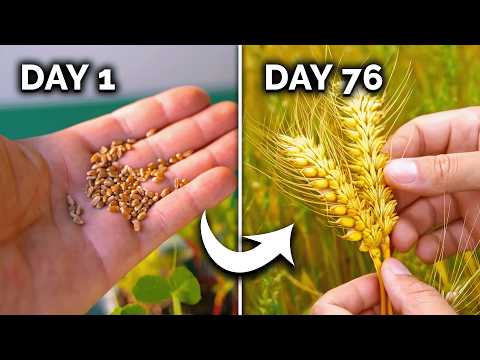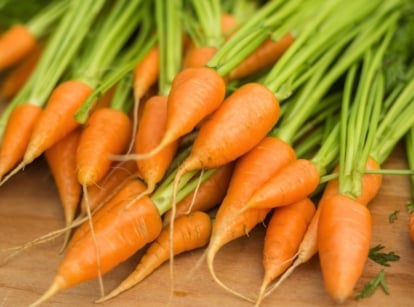7 Crops You Can Plant From Seed in April
When spring finally spoils us with sunshine and warmth, it’s a pleasure to get in the garden and sow some seeds. Join former organic farmer Logan Hailey for some delicious additions to plant from seed in your April garden.

Contents
Whether April brings showers or sunshine, this is one of the best times of year to plant garden seeds both indoors and outdoors. Soils are warming, and last frost dates have passed for many. Cool-weather vegetables still shine in the lingering chilly nights, while warm-weather crops can get a headstart inside or in the garden, depending on your climate.
This guide includes the top seven crops to start from seed this April and how you can modify your planting dates or methods based on your unique weather patterns.
What Can I Plant in April? 7 Crops to Grow From Seed
With the spring season in full swing, all the excitement of winter seed catalogues can finally come to fruition! This is the perfect time to transplant any seedlings you already sowed indoors, but there is also an abundance of crops to start from seed this month.
Cilantro

Although we usually associate cilantro with midsummer salsas and tacos, this herb prefers the cooler winter and spring weather. If you sow cilantro in April, be sure to choose a bolt-resistant variety like ‘Slow Bolt’ or ‘Long Standing Santo.’ These types will continue producing leafy herbaceous growth into the summer months. As long as you keep them well-watered and harvest regularly, they are unlikely to go to seed until the fall.
If you have a lot of problems with bolting cilantro, feel free to succession-sow the herb every few weeks to maintain a continuous supply. Hot climate growers can companion plant cilantro in the dappled shade of tomatoes or trellised cucumbers.
Winter Squash

Butternuts, pumpkins, acorn squash, kabocha, and other winter squash varieties only have “winter” in their name because they are bred to have thick skins that store through winter. These warmth-loving cucurbit vines still need summer weather to grow, flower, and mature into large fruits. In fact, winter squash cannot handle subfreezing temperatures, so you shouldn’t plant outdoors until you are safely a week or two past your expected last frost date.
Like most cucurbit-family crops, squashes prefer to be directly sown in warm soil. The large seeds germinate a tender taproot that dislikes disturbance. If you must transplant, be sure to use soil blocks, biodegradable pots, or root-protective cube pots that can easily be moved into the garden. ‘Waltham Butternut’ is a delicious selection for sweet, creamy butternut squash soups this fall.
Summer Squash

Although its name seems to imply the opposite of winter squash, summer squash varieties are grown in almost the exact same way. The key difference is that these crops yield fruits with thin skins that can be used throughout the summer months. They do not need to be cured or stored.
Zucchini like ‘Emerald Delight’ and yellow squash like ‘Early Prolific Straightneck’ are highly desired by chefs and home cooks alike. The fast-growing plants yield their first tender squash in as little as 45 days and continue producing until fall frosts arrive. Direct sow them in the garden as soon as the soil is reliably above 70°F (21°C). Use row fabric to protect from early-season pests and chilly nights.
Cucumber

Yet another member of the cucurbit family, cucumbers have a lot in common with their squash relatives. Their seeds do best when directly sown around April or May because transplanting can disturb the plants’ delicate taproots. The vines enjoy rambling, but I prefer to let them grow upward on a trellis to keep them elevated off the ground.
‘Tendergreen’ is a deliciously crisp and burpless variety. This means that it has little to no bitterness, thanks to low levels of a compound called cucurbitacin. It is also resistant to powdery mildew and tolerant of cooler soils.
Beans

Whether you choose to direct-sow or transplant, beans are the ideal spring crop for warming weather. These tasty legumes thrive in warm soil and sunshine. Pole varieties like ‘Triofo Violetto’ and ‘Kentucky Wonder’ grow as lovely climbers on fences and trellises, while ‘Contender’ or ‘Ferrari’ bush beans grow low to the ground in containers or in companion plantings with neighboring crops.
Sow bean seeds at a depth twice their largest dimension, usually around 1 inch deep. The secret to continuously-yielding beans is to harvest them regularly. As you pick more mature green beans, the plant will produce more flowers and, eventually, more pods. Some April-planted seeds may pause production during the hottest months but can return to developing beans in the fall.
Onions

On northern farms, onions are typically one of the first seeds we sow in the greenhouse in early spring. However, April leaves plenty of time to start bulbs for harvesting later in the summer and early in the fall. Long-day onions are ideal for cool-climate and high-elevation gardeners, while short-day varieties are best for warm southern gardens.
‘Zebrune’ shallots add a fancy flair to culinary harvests with a lighter, garlic-like flavor and pretty copper-colored wrapper on the torpedo-shaped bulb. These shallots resist bolting and are perfect for warm climates. They still take 100 days to mature, and are best sown in early spring as soon as the ground is workable.
For a quicker harvest, try some bunching scallions like ‘Tokyo Long White Bunching.’ These onions can be sown in clusters of 3-4 and harvested in bunches for quick garnishes.
Tomatoes

Many of us have already started tomatoes indoors by the time April rolls around, but if you haven’t already, there is still plenty of time! Tomatoes are the quintessential summer crop that grow remarkably quickly.
Contrary to popular belief, they can also be successively sowed throughout the warm season. You don’t need a “one and done” tomato crop; you can plant an early, mid, and late-season succession to ensure a continuous harvest of different varieties for different uses.
On commercial organic farms, we always start tomatoes indoors or in greenhouses to ensure strong transplants, but direct seeding can still be successful in properly irrigated, warm-weather gardens. Use a soil temperature probe to ensure your beds are at least 60°F (16°C). ‘Sun Golds’ are my all-time favorite cherry type, and ‘Glacier Bush’ are great early-season slicers.
Growers in cooler areas should prioritize indoor seeding to ensure their baby plants are strong enough to withstand the lingering cool nights of spring. Use row cover or cold frames to protect young plants while they establish.












